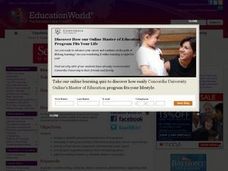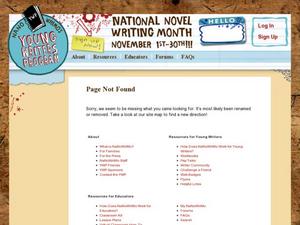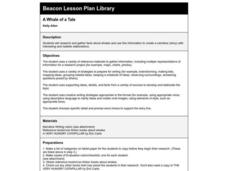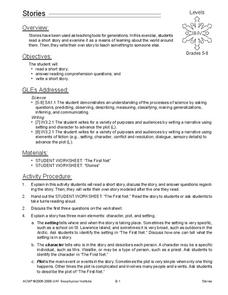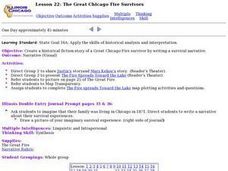Curated OER
Lesson Plan 4: Creating Main Characters
Creating a good main character is a must when writing a creative narrative or novel. Elementary aged writers create main characters for the novel they are writing. They first use themselves as a models, then create a character as a...
Pennsylvania Department of Education
Analyzing Literary Elements in Fiction
Students analyze the characters and events in fictional writing. In this literary elements lesson, students study the meaning of the words characterization and fiction. They listen to the story Pigsty by Mark Teague, or any other book...
Curated OER
Beanie Baby Biographies
Learners write a biography for their favorite Beanie Babies and then share their biography out loud. A simple, yet effective idea! Everyone loves their Beanie Baby!
Curated OER
Rudyard Kipling's Rikki-Tikki-Tavi: Mixing Words and Pictures
Create meaningful illustrations to accompany stories in a web-based art and literacy lesson plan focused on "Rikki-Tikki-Tavi" by Rudyard Kipling. The class takes a virtual art safari with the Museum of Modern Art and then discusses how...
Curated OER
Blending Fiction and Nonfiction to Improve Comprehension and Writing Skills
Students explore a content area by reading both fiction and nonfiction texts on the topic. They do more research online about the topic. After comparing the texts, they create their own written original work, using both narrative and...
Curated OER
Solar System Adventure
Students study the solar system and our galaxy, then write a science fiction story based on what they discover. They utilize worksheets and access websites imbedded in this plan to gain ideas for their stories.
Curated OER
Lesson Plan 5: Creating a Supporting Character
As a class, young writers learn how to develop a strong supporting character. They think and discuss a good friend they know, they use that friend as a basis for a potential supporting character. They create a supporting character as a...
Curated OER
A Whale of a Tale
Students read "A Very Hungry Caterpillar" and discuss factual information in the book. They research whales and use information to write a narrative story. They take their stories through the writing process.
Curated OER
Deduction
Students investigate the linguistic devices used by writers to create meaning. In this writing instructional activity, students discover why writers write in different ways showing examples of different types of text. After reading each...
Curated OER
Adding Details Using Rainbow Writing
Learners use the rainbow technique to add details to their writing. In this writing lesson plan, students practice showing not telling to add visualization to their writing.
Alabama Learning Exchange
Weather Instruments For Sale
Students create advertisements for a weather instrument. They conduct Internet research, write a descriptive and persuasive advertisement for the instrument using the flyer template of desktop publishing software, and print a copy that...
Curated OER
A Day in the Life of a Leprechaun
Young scholars investigate creative writing by reading Leprechaun stories. In this Irish culture lesson, students listen as their teacher describes what a leprechaun is and where the idea for the creature came from. Young scholars write...
Curated OER
Breaking the Chains, Rising Out of Circumstances
Discuss the history of slavery by analyzing historic photography depicting slavery. Learners write fictional stories based on these photographs. This is a creative and motivating way to launch a discussion of these topics.
Curated OER
The Time I Got Lost
Third graders go through the writing process but substitute paper and pencil with the computer to create a story about "The Time I Got Lost".
Curated OER
Stories
Students read and write a short story. In this short story lesson plan, students read a short story and answer comprehension questions on it that teaches them about the world around them. Then they write a short story to teach something...
Curated OER
Writing a News Article
In this writing worksheet, students learn the essentials about how to write a newspaper article in journalistic style. Students read about style, headlines, bylines, first, middle and ending paragraphs. After reading this, students will...
Curated OER
And Tomorrow's Forecast Is...
Students create original short stories that feature distinctive weather phenomena, such as rainbows, snowstorms, tornadoes, thunder and/or lightning. They use a story map, imbedded in this plane, to help them organize their story.
Curated OER
Holidays Around the World
Students explore how different holiday traditions are celebrated around the world. Scholars write a paper describing how they celebrate their own favorite holiday. Email partners, from different states and countries, share their...
Curated OER
Forms Of Knowledge
Learners put writing pieces into categories to show different organizational features in writing. In this writing lesson plan, students are shown examples of speeches, poems, editorials, cartoons, parodies, historical fiction, and more.
Curated OER
CREATE A NEW RHYME
Third graders develop basic narratives. They retell a focused story and create a basic publication using available resources (e.g., pictures, colors, computer, copier). They experiment with different forms of creative writing (e.g.,...
Curated OER
Historic Places in Kansas
Third graders explore the significance of historical landmarks. In this lesson, 3rd graders participate in a class discussion on Kansas landmarks, then complete several activities the reinforce the class discussion, such as writing a story.
Curated OER
Summarizing with Somebody Wanted But So
Teach your young readers how to summarize a text using a strategy called Somebody Wanted But So. Kids identify the character (Somebody), the motivation (Wanted), the conflict (But), and the resolution (So). The resource comes with...
Curated OER
Lesson 22: The Great Chicago Fire Survivors
Students, in groups, create a historical fiction story of a Great Chicago Fire survivor by writing a survival narrative.
Curated OER
Talking Book Author Project
Students explore fiction, non-fiction, and autobiographies. They create their own stories using one of the categories. Students create a PowerPoint presentation to tell their story.




